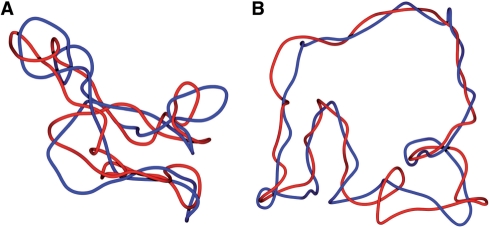Figure 7.
Limited levels of (−) supercoiling decompacts highly interlinked catenanes. Smoothed snapshots of equilibrated configurations of catenanes with Ca = 19, which component rings are either free of torsional tension (ΔLk = 0) (A) or are mildly (−) supercoiled (ΔLk = −5) (B). (A) Highly interlinked catenane with component rings that are free of torsional tension adopt a twisted configuration since this lowers their elastic energy. The same conclusion was reached in simulation studies of highly linked nicked DNA circles (20). (B) Introduction of torsional stress, which would have resulted from two catalytic cycles of DNA gyrase on each of torsionally relaxed but covalently closed component DNA rings, brings the catenanes into a more open configuration with a more regular toroidal structure.

